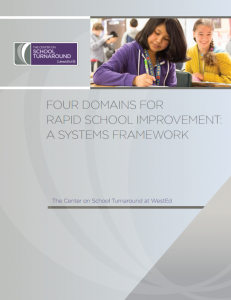Four Domains for Rapid School Improvement: A Systems Framework
The Center on School Turnaround at WestEd (CST) has released the Four Domains for Rapid School Improvement. This framework was to assist states, districts, and schools in leading and managing rapid improvement efforts. The framework shares, in practical language, the critical practices of successful school turnaround in four domains, or areas of focus, that research and experience suggest are central to rapid and significant improvement: turnaround leadership, talent development, instructional transformation, and culture shift. At a more fine-grained level, the framework then offers examples of how each practice would be put into action at each level of the system.
The framework reflects the understanding that local context and implementation influence the outcomes of any improvement initiative. It further reflects lessons learned from the federal School Improvement Grants program:
A successful school turnaround requires a systems approach with coherent guidance and support from the state and district to complement the actions of the school; and
A successful school turnaround is more than the initial jolt of bold changes in structure, authority, and personnel; it includes phases in which effective practices and processes are routinized and sustained.
The domains and practices identified in the framework that follows apply across the system of the state education agency, the local education agency, and the school. For each practice, the roles of the state, the district, and the school are briefly outlined, providing examples of their reciprocal roles in successful school improvement efforts. The domains are not meant to be considered in isolation, or to be approached in a step-by-step manner. The domains and practices overlap, with some consistent threads tying them together, including the need for clear goals and expectations, for tailored support, and for accountability to encourage a positive environment that is focused on improving student achievement in the lowest performing schools. Further, the practices are not provided in a suggested order of implementation. A turnaround plan should consider the most appropriate prioritization of the implementation of practices. Ideally, many practices will be implemented simultaneously, but it would be difficult and even counterproductive to focus on too many areas or practices at once.

